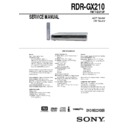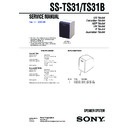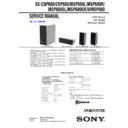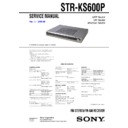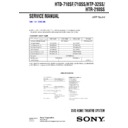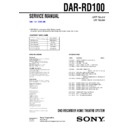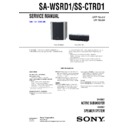Sony DAR-RD100 / HTR-210SS Service Manual ▷ View online
AEP Model
UK Model
SERVICE MANUAL
DVD RECORDER
SPECIFICATIONS
RMT-D215P
RDR-GX210
System
Laser: Semiconductor laser
Channel coverage:
Channel coverage:
PAL/SECAM (B/G, D/K, I, L)
VHF: E2 to E12, R1 to R12, F1 to F10, Italian
A to H, Ireland A to J, South Africa 4 to 13/
UHF: E21 to E69, R21 to R69, B21 to B69,
F21 to F69/CATV: S01 to S05, S1 to S20,
France B to Q/HYPER: S21 to S41
VHF: E2 to E12, R1 to R12, F1 to F10, Italian
A to H, Ireland A to J, South Africa 4 to 13/
UHF: E21 to E69, R21 to R69, B21 to B69,
F21 to F69/CATV: S01 to S05, S1 to S20,
France B to Q/HYPER: S21 to S41
The above channel coverage merely ensures the
channel reception within these ranges. It does
not guarantee the ability to receive signals in
all circumstances.
channel reception within these ranges. It does
not guarantee the ability to receive signals in
all circumstances.
Video reception: Frequency synthesizer system
Audio reception: Split carrier system
Aerial out: 75-ohm asymmetrical aerial socket
Timer: Clock: Quartz locked/Timer indication:
Audio reception: Split carrier system
Aerial out: 75-ohm asymmetrical aerial socket
Timer: Clock: Quartz locked/Timer indication:
24-hour cycle (digital)
Video recording format: MPEG Video
Audio recording format: Dolby Digital/2 ch
Audio recording format: Dolby Digital/2 ch
Inputs and outputs
LINE 2 OUT
(AUDIO): Phono jack/2 Vrms/600 ohms
(VIDEO): Phono jack/1.0 Vp-p
(S VIDEO): 4-pin mini DIN/Y:1.0 Vp-p,
(AUDIO): Phono jack/2 Vrms/600 ohms
(VIDEO): Phono jack/1.0 Vp-p
(S VIDEO): 4-pin mini DIN/Y:1.0 Vp-p,
C: 0.3 Vp-p (PAL)
LINE 2 IN/LINE 4 IN
(AUDIO): Phono jack/2 Vrms/more than 47
(AUDIO): Phono jack/2 Vrms/more than 47
kilohms
(VIDEO): Phono jack/1.0 Vp-p
(S VIDEO): 4-pin mini DIN/Y:1.0 Vp-p,
(S VIDEO): 4-pin mini DIN/Y:1.0 Vp-p,
C: 0.3 Vp-p (PAL)
LINE 1 -TV: 21-pin
CVBS IN/OUT
RGB OUT (upstream)
RGB OUT (upstream)
LINE 3/DECODER: 21-pin
CVBS IN/OUT
RGB IN
Decoder
RGB IN
Decoder
DV IN: 4-pin/i.LINK S100
DIGITAL OUT (OPTICAL): Optical output
DIGITAL OUT (OPTICAL): Optical output
jack/–18 dBm (wave length: 660 nm)
DIGITAL OUT (COAXIAL): Phono jack/
0.5 Vp-p/75 ohms
COMPONENT VIDEO OUT
(Y, P
B
/C
B
, P
R
/C
R
):
Phono jack/Y: 1.0 Vp-p, P
B
/C
B
: 0.7 Vp-p,
P
R
/C
R
: 0.7 Vp-p
General
Power requirements: 220-240 V AC, 50/60 Hz
Power consumption: 30W
Dimensions (approx.): 430
Power consumption: 30W
Dimensions (approx.): 430
× 75 × 293 mm
(width/height/depth) incl. projecting parts
Mass (approx.): 4.0 kg
Operating temperature: 5
Operating temperature: 5
°C to 35 °C
Operating humidity: 25 % to 80 %
Supplied accessories:
Supplied accessories:
Audio cord (1)
Video cord (1)
Aerial cable (1)
Remote commander (remote) (1)
R6 (size AA) batteries (2)
Video cord (1)
Aerial cable (1)
Remote commander (remote) (1)
R6 (size AA) batteries (2)
Specifications and design are subject to change
without notice.
without notice.
Compatible colour systems
This recorder is designed to record and play
using the PAL colour system.
The signals of the SECAM colour system can
be received or recorded but played back in the
PAL colour system only. Recording of video
sources based on other colour systems cannot
be guaranteed.
using the PAL colour system.
The signals of the SECAM colour system can
be received or recorded but played back in the
PAL colour system only. Recording of video
sources based on other colour systems cannot
be guaranteed.
— 2 —
SAFETY CHECK-OUT
After correcting the original service problem, perform the following
safety checks before releasing the set to the customer:
safety checks before releasing the set to the customer:
WARNING!!
WHEN SERVICING, DO NOT APPROACH THE LASER
EXIT WITH THE EYE TOO CLOSELY. IN CASE IT IS
NECESSARY TO CONFIRM LASER BEAM EMISSION,
BE SURE TO OBSERVE FROM A DISTANCE OF MORE
THAN 25 cm FROM THE SURFACE OF THE OBJECTIVE
LENS ON THE OPTICAL PICK-UP BLOCK.
EXIT WITH THE EYE TOO CLOSELY. IN CASE IT IS
NECESSARY TO CONFIRM LASER BEAM EMISSION,
BE SURE TO OBSERVE FROM A DISTANCE OF MORE
THAN 25 cm FROM THE SURFACE OF THE OBJECTIVE
LENS ON THE OPTICAL PICK-UP BLOCK.
CAUTION
Use of controls or adjustments or performance of procedures
other than those specified herein may result in hazardous
radiation exposure.
other than those specified herein may result in hazardous
radiation exposure.
SAFETY-RELATED COMPONENT WARNING!!
COMPONENTS IDENTIFIED BY MARK
0
OR DOTTED LINE
WITH MARK
0
ON THE SCHEMATIC DIAGRAMS AND IN
THE PARTS LIST ARE CRITICAL TO SAFE OPERATION.
REPLACE THESE COMPONENTS WITH SONY PARTS
WHOSE PART NUMBERS APPEAR AS SHOWN IN THIS
MANUAL OR IN SUPPLEMENTS PUBLISHED BY SONY.
REPLACE THESE COMPONENTS WITH SONY PARTS
WHOSE PART NUMBERS APPEAR AS SHOWN IN THIS
MANUAL OR IN SUPPLEMENTS PUBLISHED BY SONY.
1. Check the area of your repair for unsoldered or poorly-soldered
connections. Check the entire board surface for solder splashes
and bridges.
and bridges.
2. Check the interboard wiring to ensure that no wires are “pinched”
or contact high-wattage resistors.
3. Look for unauthorized replacement parts, particularly transistors,
that were installed during a previous repair. Point them out to
the customer and recommend their replacement.
the customer and recommend their replacement.
This appliance is classified as
a CLASS 1 LASER product.
The CLASS 1 LASER
PRODUCT MARKING is
located on the rear exterior.
a CLASS 1 LASER product.
The CLASS 1 LASER
PRODUCT MARKING is
located on the rear exterior.
Unleaded solder
Boards requiring use of unleaded solder are printed with the lead-
free mark (LF) indicating the solder contains no lead.
(Caution: Some printed circuit boards may not come printed with
the lead free mark due to their particular size.)
free mark (LF) indicating the solder contains no lead.
(Caution: Some printed circuit boards may not come printed with
the lead free mark due to their particular size.)
: LEAD FREE MARK
Unleaded solder has the following characteristics.
• Unleaded solder melts at a temperature about 40
• Unleaded solder melts at a temperature about 40
°C higher than
ordinary solder.
Ordinary soldering irons can be used but the iron tip has to be
applied to the solder joint for a slightly longer time.
Soldering irons using a temperature regulator should be set to
about 350
Ordinary soldering irons can be used but the iron tip has to be
applied to the solder joint for a slightly longer time.
Soldering irons using a temperature regulator should be set to
about 350
°C.
Caution: The printed pattern (copper foil) may peel away if the
heated tip is applied for too long, so be careful!
heated tip is applied for too long, so be careful!
• Strong viscosity
Unleaded solder is more viscous (sticky, less prone to flow) than
ordinary solder so use caution not to let solder bridges occur such
as on IC pins, etc.
ordinary solder so use caution not to let solder bridges occur such
as on IC pins, etc.
• Usable with ordinary solder
It is best to use only unleaded solder but unleaded solder may
also be added to ordinary solder.
also be added to ordinary solder.
4. Look for parts which, though functioning, show obvious signs
of deterioration. Point them out to the customer and recommend
their replacement.
their replacement.
5. Check the B+ voltage to see it is at the values specified.
CAUTION:
The use of optical instrument with this product will increase eye
hazard.
hazard.
— 3 —
TABLE OF CONTENTS
Service Note
1
Connection of Jig (Extension Cable) ·································· 4
2
Disc Removal Procedure (at Power off) ····························· 5
1.
General
Hookups and Settings ······················································ 1-3
Basic Operation ······························································· 1-6
Recording ········································································ 1-9
Playback ········································································ 1-11
Erasing and Editing ······················································· 1-14
DV Dubbing ·································································· 1-16
Settings and Adjustments ·············································· 1-17
Additional Information ·················································· 1-19
Basic Operation ······························································· 1-6
Recording ········································································ 1-9
Playback ········································································ 1-11
Erasing and Editing ······················································· 1-14
DV Dubbing ·································································· 1-16
Settings and Adjustments ·············································· 1-17
Additional Information ·················································· 1-19
2.
Disassembly
2-1
Top Case ········································································· 2-1
2-2
Front Panel Section-1 ····················································· 2-1
2-3
Front Panel Section-2 ····················································· 2-2
2-4
Video Deck Ass’y ··························································· 2-2
3.
Block Diagrams
1)
Video Block Diagram ····················································· 3-1
2)
Audio Block Diagram ···················································· 3-3
3)
Video Input/Record Path ················································ 3-5
4)
Video Output Path ·························································· 3-7
5)
Audio Input Path (Tuner, AV & DV1394) ······················ 3-9
6)
FLD/u-Com/Tuner ······················································· 3-11
7)
Power: Main Board ······················································ 3-13
4.
Schematic Diagrams
4-1
Frame (1/2) ······································································ 4-1
4-2
Frame (2/2) ······································································ 4-3
4-3
Power ··············································································· 4-5
4-4
Mpeg Encoder ································································· 4-7
4-5
Mpeg Decoder ································································· 4-9
4-6
Video Decoder & DV1394 Phy ····································· 4-11
4-7
I/O ·················································································· 4-13
4-8
Key ················································································ 4-15
4-9
Jack ················································································ 4-17
4-10 Timer ············································································· 4-19
4-11 Waveforms ····································································· 4-21
4-12 Circuit Voltage Chart ····················································· 4-23
4-11 Waveforms ····································································· 4-21
4-12 Circuit Voltage Chart ····················································· 4-23
5.
Printed Wiring Boards
5-1
Main Board ······································································ 5-1
5-2
I/O Board ········································································· 5-3
5-3
Key/Timer Board ····························································· 5-7
5-4
Jack Board ······································································· 5-9
6.
Troubleshooting
·················································
6-1
7.
Repair Parts List
7-1
Exploded Views ······························································· 7-1
7-1-1 Cabinet and Main Frame Section ···································· 7-1
7-1-2 Packing Accessory Section ·············································· 7-2
7-2
7-1-2 Packing Accessory Section ·············································· 7-2
7-2
Electrical Parts List ························································· 7-3
— 4 —
SERVICE NOTE
Video deck assy
Main board
PM101
PM102
Extension cable
(J-6090-174-A)
(J-6090-174-A)
PIM01
PIM02
I/O board
Key board
TIMER board
Jack board
SMPS board
RDR-GX210
1. CONNECTION OF JIG (EXTENSION CABLE)
•
Please use the extension cable (J-6090-174-A) as shown in the figure below when you serve the main board and I/O board.

